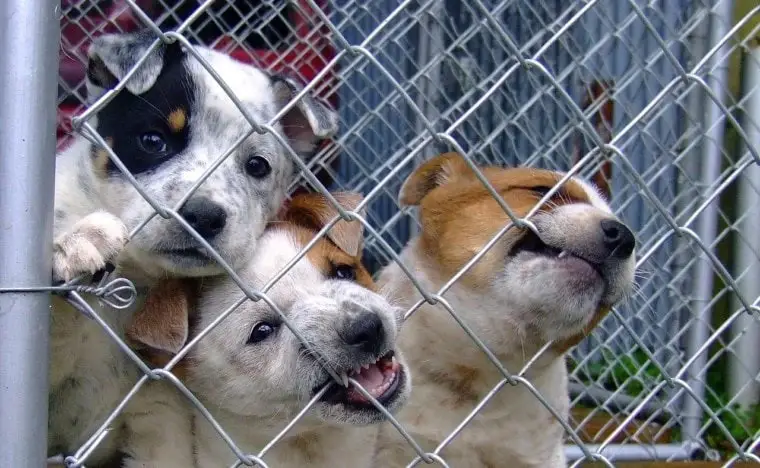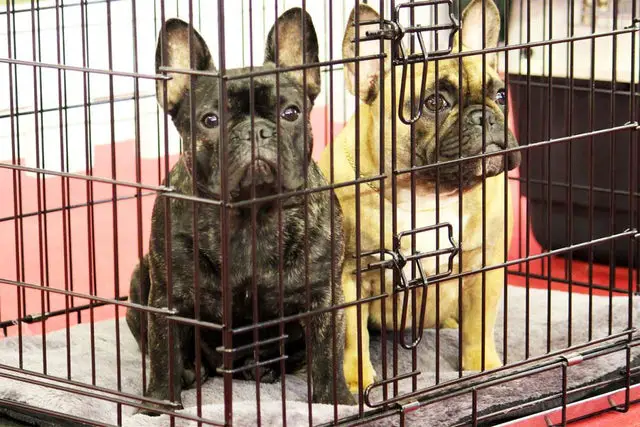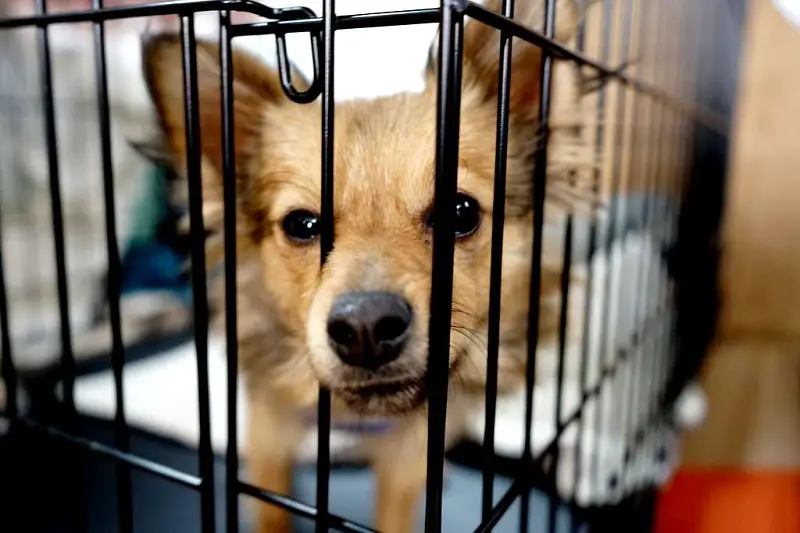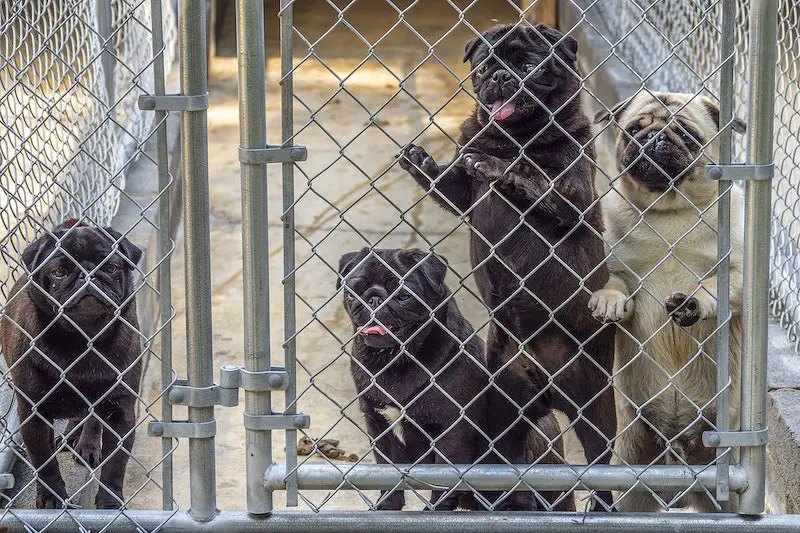Puppy mills churn out profits, churning out misery for countless dogs. Shockingly, an estimated 10,000 puppy mills operate in the US, fueling pet stores and online sales. These facilities prioritize profit over welfare, leading to horrific conditions and lifelong health issues for breeding dogs and their puppies. Delve into the disturbing statistics behind this cruel industry – from the cramped cages and lack of veterinary care to the sheer number of animals trapped in this cycle of abuse. The numbers paint a grim picture, demanding a closer look at how we can combat this inhumane practice.
Originally published on January 24, 2023, this article has been updated on October 23, 2023 to reflect the latest research and statistics. Our editorial team has ensured you’re viewing the most current data on this topic. Need help or have a question? Email us.
You felt your rate race while gently caressing the soft fur between your fingers. It’s when you discovered you have a soul—all thanks to the amber-eyed puppy thumping its tail and begging you to take it home.
Of course, you could walk away. Surely, someone will snap up the adorable puppy and give it a good home. There’ll be another puppy, according to puppy mills statistics.
They’re the urchins from a nasty side of free enterprise. These pups barely knew their mother. She’s a production machine forced to birth litter after litter.
Although the pup awakening your soul is primped and groomed, it comes from abysmal conditions and an endless number of puppy mill statistics.
Puppy Mill Facts
Yes, these puppy mills statistics are difficult to bear. Despite the Humane Society and organizations fighting bravely against these barbaric puppy mills facts and the pet stores that sell them, they need your help.
One of the biggest hurdles facing the Humane Society and other organizations is that animal laws are vague and non-existent.
Also, the AWA (Animal Welfare Act) makes no clear distinction between puppy mills and farm animals. It’s easy for puppy mill owners to operate without consequences. And no one keeps accurate records.
Puppy Mill Statistics
Below are some puppy mill statistics enough to crush an empath’s heart.
There Are Around 10,000 Puppy Mills in the U.S. According to the Humane Society US (HSUS)
HSUS fights relentlessly against these commercial dog breeding hubs that sell to pet stores, through online venues, or at flea markets and classified ads.
Only 3000 puppy mills get inspections through the arm of the U.S. Department of Agriculture (USDA). Further, these animals have no legal representation against these emotionally and physically abusive institutions according to animal cruelty laws.
Sixteen States Have No Laws Related to Puppy Mills at All (Humane Society)
Sadly, organizations have to battle non-existing laws to protect and rescue canines from inhumane commercial dog breeding factories.
Since most puppy mills are not illegal, HSUS works tirelessly to educate the public about how these mills abuse animals. Currently, there are 16 states in the US that don’t have any puppy mills-related laws. The HSUS begs you to rescue a dog from animal shelters and help break the puppy mill cycle.
Although the Humane Society has its hands tied legally, it champions lawmakers to improve the standards of horrid care in puppy mills.
Further, the HSUS continues to fight to upgrade the Animal Welfare Act to protect animals. Since 2006, the HSUS has rescued over 11,000 dogs from over 50 legal puppy mills.
Around 30% of Puppy Mills Are USDA-Licensed (Animal Law Info)
Even looking at photos of these USDA-licensed and unlicensed commercial dog breeding facilities that sell puppies is heart-wrenching. The laws that are supposed to protect animals leave a gapping hole for dog abuse.
Merciless dog breeders sell puppies and operate without consequences. They produce hundreds of thousands of abused puppies in 10,000 puppy mills.
Even the Inspector General of the USDA stated in an internal audit that A.C. failed to protect animals against problem dealers.
500,000 Dogs Are Currently Kept in Puppy Mills for Breeding Purposes (Humane Society)
Almost 500,000 dogs are kept in puppy mills just for the sake of breeding. The year is 2023, and we’re still fighting to stop offenders from relentlessly breeding females in cramped cages without veterinary care. Unfortunately, puppy mill stats reveal there are only a few laws to prevent these dogs from spending their entire lives in cells.
Although animal rights groups fight to ban pet shops from selling and prevent disease and cruelty, a kennel owner can still maximize profits through neglect and overbreeding.
Dogs in Puppy Mills Are Cramped in Cages 24/7, With Almost No Room To Exercise or Play (HSVMA)
Puppy mills use crude kennels made of the cheapest wire mesh and wood cages. Some house dogs with their puppies outdoors.
Dogs live exposed to the elements and their own filth. They receive low-quality dog food, no affection, or veterinary care. Female dogs produce litter after litter until they’re killed or auctioned off to pet stores.
Dogs From Puppy Mills Show Consistent Behavioral and Psychological Abnormalities (Science Direct)
It’s not just some well-meaning person’s opinion. Seven published studies confirm that puppy mill products sold online or in retail pet stores never fully develop into emotionally healthy dogs.
The study finds that these pets continue to experience distress into adulthood compared to dogs from non-commercial breeders.
Mill Puppies Are 41.6% More Likely To Develop Health Problems Than the General Dog Population (Spots)
Veterinarians see it all. They see dogs and puppies from loving homes and puppies born in puppy mills. While many people have the best intentions when they buy a puppy mill dog, these dogs will experience a lifetime of health issues and never fully recover from the trauma.
Half the puppies born survive to live 12 weeks. Most puppy mills sell puppies that suffer from behavior, genetic health problems, severe parasitism, heart disease, periodontal defects, and many others.
According to the HSUS Horrible Hundred Report of 2023, Missouri Has the Highest Number of Dealers (HSUS)
The number of dealers in Missouri is 31. Houston, we have a problem. “A breeding female Weimaraner was one of more than 30 dogs seized from an American Kennel Club breeder in North Carolina in December 2019. She was pregnant, severely emaciated, and gave birth to seven puppies, four of whom were deceased. As of April 25, 2020, the courts are still considering returning some of the dogs to the breeder. / Anonymous, 2019.”
Listed directly from the Humane Society’s Horrible Hundred Repeat Offenders.
Almost 2 Million Dogs Die in Puppy Mills Annually (Spots)
There are no accurate puppy mill death statistics as they are not obliged to report them, still, it is roughly estimated that around 2 million puppies die annually in puppy mills. I guess that’s why America is the land of the free. No one monitors these poor animals kept in puppy mills’ illegal standards.
The AWA (Animal Welfare Act) is a joke and protects the monsters who abuse animals. The existing laws are outdated, and special interest groups overturn any amendments to create rules to save animals.
The USDA can inspect licensed puppy mill facilities (a smaller percentage of the actual such facilities). These regulations require that cages are six inches larger than the dog. Unfreaking believable!
Statistics Reveal That Most Puppies Sold in Stores Come From Puppy Mills (Paws.org)
Puppy mills are legal and supply 90% of dogs sold in pet stores. They also provided puppies to labs for animal testing. According to the Humane Society, Petland is the last national pet chain that sells puppies.
Licensed U.S. Puppy Mills Produce Over a Million Puppies Each Year (HSUS)
To clarify, the 3,000 licensed puppy mills produce, sell, and abuse 1,307,407 puppies yearly. This number does not include the unlicensed 7,000 facilities.
People Got Infected With Campylobacter Jejuni From Puppies in a Pet Store (CDC)
Between January 2019 and March 2021, 56 people in 17 states contacted Campylobacter jejuni. The source of the outbreak was puppies in pet stores.
Five of the infected were Petland staff, and 13 of 21 had a link to Petland (further proof that Petland continues to sell puppy mill pets).
There Are 400 Humane Pet Sales Laws in Place (Best Friends)
There are more than 400 humane pet sale laws across North America. The effort to see laws change is thanks to many amazing people.
Elizabeth Oreck states, “The way to eliminate puppy and kitten mills is to target their profits by encouraging people not to support this cruel industry.” Hundreds of cities, counties, and other states use humane pet sales laws.
Oreck and her team led the way to encourage pet stores to focus on helping pet owners adopt dogs and cats from local shelters instead of selling puppy mill goods.
The First State to Ban Retail Pet Sales Was California (ASPCA)
National animal welfare organizations and activists celebrated when California signed a new law to prevent pet stores from selling commercially bred dogs, cats, and rabbits. Instead, the law encourages the adoption of rescue dogs from animal shelters. It’s a win-win.
Fewer Than 3,000 Puppy Mills Are Regulated (HSUS)
Although over 10,000 puppy mills exist in the USA, less than 3,000 are USDA-registered. These 3,000 facilities had to report because they bred more than four females. However, many of these unscrupulous breeders know how to circumvent the law.
Pet Store and Puppy Mill Statistics Show 113 People Infected With Campylobacter in 2018 (CDC)
The CDC conducted a thorough investigation into the events that led to the infection of 113 people. It found that 99% of people infected had contact with a puppy before the illness.
Of those, 87% had contact with infected puppies or someone who had contact with a Petland store puppy. Twenty-five of those were employees of Petland stores.
Transporters of the Puppy Mills Supply Chain Should Provide Food and Water Every 12 Hours, but It Is Rarely Enforced (ASPCA)
Do you ever wonder how much lower humanity can go? The individuals who transport puppy mill cargo surely know these said puppies have already endured more suffering than anyone could wish on their worst enemy.
However, these transporters or puppy wholesalers ship these puppies off without food or water in cramped cages. Many times, puppies arrived dead.
93 Dogs Killed in a Homemade Gas Chamber in 2010 (Syracuse)
Surprise, we can go lower. A guy once gassed 93 of his dogs in a crude gas chamber in Syracuse. This person was also under investigation by the USDA and Seneca County sheriff for other offenses.
If he were found guilty of violating the Animal Welfare Act, he would face $10,000 for each violation. However, according to online sources, he got fined $505 in total.
Missouri Had the Most Problem Puppy Mills for 8 Years (HSUS)
The state of Missouri continues to have the largest number of puppy mills for 8 years in a row and has nothing to be proud of. The Humane Society and its research team spent hours scouring inspection records to update their Horrible Hundred report.
They don’t do it for enjoyment. The HSUS team champions animal rights and wants laws protecting innocent animals from endless suffering.
Dog Brokers Pay Between $50–$150 for Puppies From Puppy Mills (Knoji)
Everyone wants to make a buck off these puppy mills. Brokers or intermediaries sell puppies from commercial dog farms and backyard breeders and charm their way into retail stores.
They buy in bulk for about $50 to $150 per pet and sell it to your local pet shop for $200 and $400. The pet chain sells it to you at super-inflated prices of $1,000 to $1,400.
Around $80,000 Spent in Snohomish County Due to Puppy Mills, Unlicensed Breeders, and Animal Neglect (HeraldNet)
When an unlicensed breeder gets charged with animal neglect, the burden falls onto the county and the taxpayer.
Snohomish County has spent vast sums on sheltering animals from over 12 criminal cases. When local authorities rescue pets from an unlicensed breeder because of neglect, it costs money they can never recoup (remember the $505 fine in Syracuse).
The total number of puppy mill puppies sold is around 2.6 million (HSUS)
Fact: Americans love their dogs. Sadly, that doesn’t mean every American. It’s heart-wrenching to tear your eyes and heart away from a puppy you know has already endured more than is right. But it’s that heart-wrenching theory that keeps puppy mill breeders in business.
It’s why 2.6 million people took home a puppy from a puppy mill. But according to the American Grooming Academy, the number of sold puppies produced by puppy mills is 2.04 million.
However, many of these puppies end up in shelters too. Many dogs die. They often have expensive health issues and behavior problems that not everyone can handle.
Dog Farming Plays a Huge Part in the Amish Economy (Stop Online Puppy Mills)
You’re not alone if you thought the Amish made nice furniture and drove a horse and buggy. Hard to fathom that the Amish are puppy mill conglomerates that fly under the radar.
Many Amish puppy mills are in Indiana, Ohio, Michigan, and Pennsylvania. They run significant operations with up to 1,000 dogs that spend their lives in inhumane cages.
There Are Claims That 20% of All Puppy Mills Are Amish Mills (Snopes)
Many Amish run licensed and unlicensed puppy mills in Pennsylvania, Indiana, and Ohio. Many of the dogs live in horrific conditions. However, since these dog factories are poorly regulated, saying 20% are Amish can’t be substantiated (even if it says so on Facebook).
Perhaps they’ve found something more lucrative than barn raising.
Statistics Show That One Amish Puppy Mill Owner Sold 1,293 Puppies in Just a Year (Michigan Puppy Mills USDA, Change.org)
It’s challenging to prove some claims made on the internet since these puppy mill breeders aren’t required to produce sales figures, deaths, or illnesses. A federal investigation into one farmer revealed a long history of violations. The report suggested ongoing incidences of neglect and abuse as far back as 1992.
The violations included poor sanitation, inadequate water and food, overcrowding, and insufficient pest control. That this person made $290,000 can’t be substantiated with proof.
The Amish Take Part in Four Areas of Animal Breeding (Amish America)
The Amish were famous for dairy farms, but they’re now breeding exotic pets, deer, horses, and dogs. Some exotic pets are parrots, zebras, and capybaras (rodents).
Horse farming is very lucrative for many Amish, who have diversified to whitetail deers for their antlers. We already discussed Amish selling puppies of multiple breeds.
The Amish Run Over 98% of Puppy Mills in Ohio (Shiba Rescue)
According to Bailing Out Benji, there are 470 kennels in Holmes County, Ohio. Puppy mills in Ohio, from small to large scale operations, abuse, and neglect over 20,000 breeding dogs. Nine of these mills have the distinction of being the worst in the country.
Dog Breeding Statistics
There Are About 167,388 Breeding Dogs in Licensed Facilities (Harts Shelter)
These breeding dogs are used like machines to produce litter after litter without concern for their health or well-being. The cages are barely big enough, and when they stop producing, breeders kill them.
Each Female Produces an Average of 9.4 Puppies Yearly (HSUS)
Female dogs produce, on average, for 5.5 to 6 years. Which may seem short, but when they spend their entire lives bred continuously, that is long in dog years. On average, 77,000 females are replaced because they no longer produce to maximize profits.
Most Females Bred Every Heat Cycle and Given Little Time to Recover (Do Something)
The best way to tackle the best breeding methods for a dog is by consulting a qualified vet. Breeding female dogs require additional nutrients and deserve some pampering in a healthy environment.
Many Puppies Die As Their Mother Can’t Produce Enough Milk (VCA Hospital)
Nursing females need a healthy diet to produce milk. Puppy mills and backyard breeders notoriously neglect dogs and provide cheap dog food; ultimately, the female dogs get infected. This can cause the death of an entire litter within 24-48 hours. Therefore, a new puppy doesn’t have hope.
Puppies Weaned From Their Mothers Too Young, Leading to Mental and Physical Issues (Veterinary Practice)
Puppies need their mothers. Otherwise, they develop psychological and behavioral issues like anxiety. The first few months in a dog’s life are crucial for its development.
How to Differentiate Between a Good Breeder and a Puppy Mill?
A good breeder typically invites you to visit their facilities because they have nothing to hide. They also want to interview you to see if you’re a good fit. Following are a few ways to distinguish between a reputable breeder and a puppy mill.
- Get references from previous clients
- Read reviews
- Meet the puppy’s parents
- Ask to speak with the vet they use
- Get documentation supporting the dog’s lineage (a pedigree shows 3-5 generations)
- Offers a buy-back plan
- Get a list of illnesses, if any (genetic), vaccinations, vet care, etc.
- Asks you as many questions about the puppy’s future home
- If you can’t visit the facility, ask for a video tour
- Buyer beware
How to Stop Puppy Mills?
The only way to stop puppy mills is to stop buying from pet stores, backyard, or flea market breeders and to spread the word.
Refuse to support stores like Petland, which continue to buy from puppy mill breeders.
FAQ’s
Below are some frequently asked questions.
What Do Puppy Mills Look Like?
Puppy mills are often crude wire cages that expose animals to the elements and have no space to move around (6-inch cage space). They’re stacked on top of each other, and dogs are forced to walk on wire. There is constant barking and stress.
How Many Puppy Mills Are There?
There are 10,000 puppy mills keeping pets in overcrowded cages in America
What Happens to Puppies in Puppy Mills?
Puppies suffer neglect and abuse and are often killed if they can’t be sold. Remember, half the puppies don’t make it past 12 weeks.
How Many Dogs Are Bought from Breeders Each Year?
Americans buy approximately 2.11 million puppies kept in cramped cages from the registered and unregistered 10,000 puppy mills in America.
How Many Puppies Die in Puppy Mills Each Year?
It’s hard to substantiate as puppy mill owners don’t keep records they share with any official agency. But if they sell 2.11 million and a half die, that’s more than a million puppies.
Conclusion
Heartbreaking animal cruelty statistics are tragic numbers to explore. While many organizations like the HSUS are constantly battling these inhumane puppy mills, we also have animal overpopulation problems.
According to the ASPCA, nearly a million shelter animals are euthanized annually. That means, as pet parents, we’re doing something wrong.
To stop puppy mills, we have to stop buying from puppy mill sources like pet stores. Instead, opt to adopt. If you want to influence change, stop animal abuse, and try putting every single puppy mill out of business. Get involved!
Sources:
* 3000
The statistics surrounding puppy mills paint a grim picture of animal welfare. Hundreds of thousands of dogs endure deplorable conditions in these facilities, suffering from neglect, overcrowding, and lack of veterinary care. While legislative efforts are underway, consumer awareness remains crucial. Choosing to adopt from shelters or reputable breeders, and avoiding pet stores supplied by puppy mills, is the most effective way to combat this inhumane industry and give deserving dogs a loving home. Only through conscious purchasing decisions can we hope to eradicate the suffering inherent in puppy mills.



















